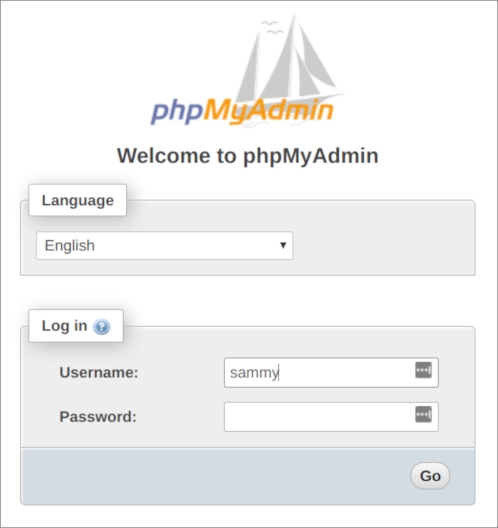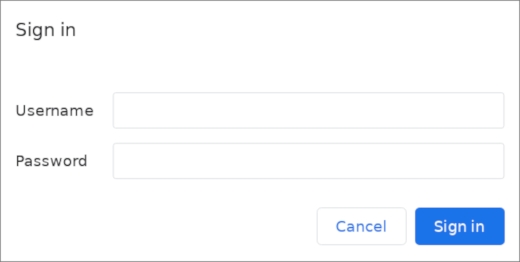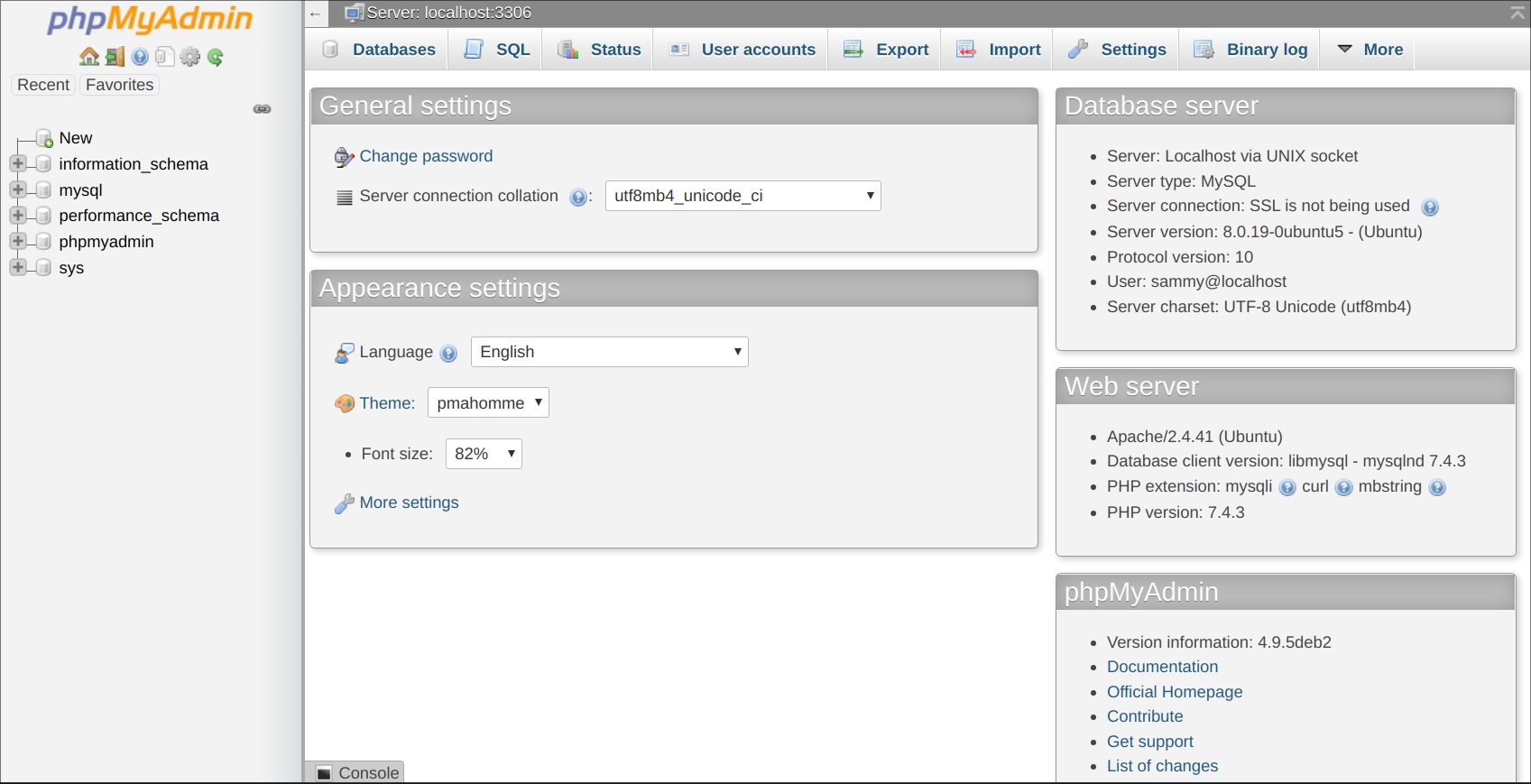How To Create a New User and Grant Permissions in MySQL
https://www.digitalocean.com/community/tutorials/how-to-install-and-secure-phpmyadmin-on-ubuntu-20-04
Last updated
https://www.digitalocean.com/community/tutorials/how-to-install-and-secure-phpmyadmin-on-ubuntu-20-04
Last updated
UbuntuApachePHPApplicationsUbuntu 20.04
By Mark DrakeLast Validated onOctober 22, 2020 Originally Published onMay 4, 2020 146.9kviews
English Deutsch Español Français Bahasa Indonesia 日本語 Português РусскийEnglish
Not using Ubuntu 20.04? Choose a different version or distribution.
Ubuntu 20.04CentOS 7Debian 9Debian 10Ubuntu 18.04Ubuntu 16.04Ubuntu 14.04Ubuntu 20.04
An earlier version of this tutorial was written by Brennan Bearnes.
While many users need the functionality of a database management system like MySQL, they may not feel comfortable interacting with the system solely from the MySQL prompt.
phpMyAdmin was created so that users can interact with MySQL through a web interface. In this guide, we’ll discuss how to install and secure phpMyAdmin so that you can safely use it to manage your databases on an Ubuntu 20.04 system.
In order to complete this guide, you will need:
An Ubuntu 20.04 server. This server should have a non-root user with administrative privileges and a firewall configured with ufw. To set this up, follow our initial server setup guide for Ubuntu 20.04.
A LAMP (Linux, Apache, MySQL, and PHP) stack installed on your Ubuntu 20.04 server. If this is not completed yet, you can follow this guide on installing a LAMP stack on Ubuntu 20.04.
Additionally, there are important security considerations when using software like phpMyAdmin, since it:
Communicates directly with your MySQL installation
Handles authentication using MySQL credentials
Executes and returns results for arbitrary SQL queries
For these reasons, and because it is a widely-deployed PHP application which is frequently targeted for attack, you should never run phpMyAdmin on remote systems over a plain HTTP connection.
If you do not have an existing domain configured with an SSL/TLS certificate, you can follow this guide on securing Apache with Let’s Encrypt on Ubuntu 20.04. This will require you to register a domain name, create DNS records for your server, and set up an Apache Virtual Host.
You can use APT to install phpMyAdmin from the default Ubuntu repositories.
As your non-root sudo user, update your server’s package index:
Copy
Following that you can install the phpmyadmin package. Along with this package, the official documentation also recommends that you install a few PHP extensions onto your server to enable certain functionalities and improve performance.
If you followed the prerequisite LAMP stack tutorial, several of these modules will have been installed along with the php package. However, it’s recommended that you also install these packages:
php-mbstring: A module for managing non-ASCII strings and convert strings to different encodings
php-zip: This extension supports uploading .zip files to phpMyAdmin
php-gd: Enables support for the GD Graphics Library
php-json: Provides PHP with support for JSON serialization
php-curl: Allows PHP to interact with different kinds of servers using different protocols
Run the following command to install these packages onto your system. Please note, though, that the installation process requires you to make some choices to configure phpMyAdmin correctly. We’ll walk through these options shortly:
Copy
Here are the options you should choose when prompted in order to configure your installation correctly:
For the server selection, choose apache2Warning: When the prompt appears, “apache2” is highlighted, but not selected. If you do not hit SPACE to select Apache, the installer will not move the necessary files during installation. Hit SPACE, TAB, and then ENTER to select Apache.
Select Yes when asked whether to use dbconfig-common to set up the database
You will then be asked to choose and confirm a MySQL application password for phpMyAdmin
Note: Assuming you installed MySQL by following Step 2 of the prerequisite LAMP stack tutorial, you may have decided to enable the Validate Password plugin. As of this writing, enabling this component will trigger an error when you attempt to set a password for the phpmyadmin user:
To resolve this, select the abort option to stop the installation process. Then, open up your MySQL prompt:
Copy
Or, if you enabled password authentication for the root MySQL user, run this command and then enter your password when prompted:
Copy
From the prompt, run the following command to disable the Validate Password component. Note that this won’t actually uninstall it, but just stop the component from being loaded on your MySQL server:
Copy
Following that, you can close the MySQL client:
Copy
Then try installing the phpmyadmin package again and it will work as expected:
Copy
Once phpMyAdmin is installed, you can open the MySQL prompt once again with sudo mysql or mysql -u root -p and then run the following command to re-enable the Validate Password component:
Copy
The installation process adds the phpMyAdmin Apache configuration file into the /etc/apache2/conf-enabled/ directory, where it is read automatically. To finish configuring Apache and PHP to work with phpMyAdmin, the only remaining task in this section of the tutorial is to is explicitly enable the mbstring PHP extension, which you can do by typing:
Copy
Afterwards, restart Apache for your changes to be recognized:
Copy
phpMyAdmin is now installed and configured to work with Apache. However, before you can log in and begin interacting with your MySQL databases, you will need to ensure that your MySQL users have the privileges required for interacting with the program.
When you installed phpMyAdmin onto your server, it automatically created a database user called phpmyadmin which performs certain underlying processes for the program. Rather than logging in as this user with the administrative password you set during installation, it’s recommended that you log in as either your root MySQL user or as a user dedicated to managing databases through the phpMyAdmin interface.
In Ubuntu systems running MySQL 5.7 (and later versions), the root MySQL user is set to authenticate using the auth_socket plugin by default rather than with a password. This allows for some greater security and usability in many cases, but it can also complicate things when you need to allow an external program — like phpMyAdmin — to access the user.
In order to log in to phpMyAdmin as your root MySQL user, you will need to switch its authentication method from auth_socket to one that makes use of a password, if you haven’t already done so. To do this, open up the MySQL prompt from your terminal:
Copy
Next, check which authentication method each of your MySQL user accounts use with the following command:
Copy
In this example, you can see that the root user does in fact authenticate using the auth_socket plugin. To configure the root account to authenticate with a password, run the following ALTER USER command. Be sure to change password to a strong password of your choosing:
Copy
Note: The previous ALTER USER statement sets the root MySQL user to authenticate with the caching_sha2_password plugin. Per the official MySQL documentation, caching_sha2_password is MySQL’s preferred authentication plugin, as it provides more secure password encryption than the older, but still widely used, mysql_native_password.
However, some versions of PHP don’t work reliably with caching_sha2_password. PHP has reported that this issue was fixed as of PHP 7.4, but if you encounter an error when trying to log in to phpMyAdmin later on, you may want to set root to authenticate with mysql_native_password instead:
Copy
Then, check the authentication methods employed by each of your users again to confirm that root no longer authenticates using the auth_socket plugin:
Copy
You can see from this output that the root user will authenticate using a password. You can now log in to the phpMyAdmin interface as your root user with the password you’ve set for it here.
Alternatively, some may find that it better suits their workflow to connect to phpMyAdmin with a dedicated user. To do this, open up the MySQL shell once again:
Copy
If you have password authentication enabled for your root user, as described in the previous section, you will need to run the following command and enter your password when prompted in order to connect:
Copy
From there, create a new user and give it a strong password:
Copy
Note: Again, depending on what version of PHP you have installed, you may want to set your new user to authenticate with mysql_native_password instead of caching_sha2_password:
Copy
Then, grant your new user appropriate privileges. For example, you could grant the user privileges to all tables within the database, as well as the power to add, change, and remove user privileges, with this command:
Copy
Following that, exit the MySQL shell:
Copy
You can now access the web interface by visiting your server’s domain name or public IP address followed by /phpmyadmin:
Log in to the interface, either as root or with the new username and password you just configured.
When you log in, you’ll see the user interface, which will look something like this:
Now that you’re able to connect and interact with phpMyAdmin, all that’s left to do is harden your system’s security to protect it from attackers.
Because of its ubiquity, phpMyAdmin is a popular target for attackers, and you should take extra care to prevent unauthorized access. One way of doing this is to place a gateway in front of the entire application by using Apache’s built-in .htaccess authentication and authorization functionalities.
To do this, you must first enable the use of .htaccess file overrides by editing your phpMyAdmin installation’s Apache configuration file.
Use your preferred text editor to edit the phpmyadmin.conf file that has been placed in your Apache configuration directory. Here, we’ll use nano:
Copy
Add an AllowOverride All directive within the <Directory /usr/share/phpmyadmin> section of the configuration file, like this:/etc/apache2/conf-available/phpmyadmin.conf
Copy
When you have added this line, save and close the file. If you used nano to edit the file, do so by pressing CTRL + X, Y, and then ENTER.
To implement the changes you made, restart Apache:
Copy
Now that you have enabled the use of .htaccess files for your application, you need to create one to actually implement some security.
In order for this to be successful, the file must be created within the application directory. You can create the necessary file and open it in your text editor with root privileges by typing:
Copy
Within this file, enter the following information:/usr/share/phpmyadmin/.htaccess
Copy
Here is what each of these lines mean:
AuthType Basic: This line specifies the authentication type that you are implementing. This type will implement password authentication using a password file.
AuthName: This sets the message for the authentication dialog box. You should keep this generic so that unauthorized users won’t gain any information about what is being protected.
AuthUserFile: This sets the location of the password file that will be used for authentication. This should be outside of the directories that are being served. We will create this file shortly.
Require valid-user: This specifies that only authenticated users should be given access to this resource. This is what actually stops unauthorized users from entering.
When you are finished, save and close the file.
The location that you selected for your password file was /etc/phpmyadmin/.htpasswd. You can now create this file and pass it an initial user with the htpasswd utility:
Copy
You will be prompted to select and confirm a password for the user you are creating. Afterwards, the file is created with the hashed password that you entered.
If you want to enter an additional user, you need to do so without the -c flag, like this:
Copy
Then restart Apache to put .htaccess authentication into effect:
Copy
Now, when you access your phpMyAdmin subdirectory, you will be prompted for the additional account name and password that you just configured:
After entering the Apache authentication, you’ll be taken to the regular phpMyAdmin authentication page to enter your MySQL credentials. By adding an extra set of non-MySQL credentials, you’re providing your database with an additional layer of security. This is desirable, since phpMyAdmin has been vulnerable to security threats in the past.
Technical Writer @ DigitalOcean
Still looking for an answer?
Ask a questionSearch for more help
Comments
23 Comments
B
I
UL
OL
Link
Code
Highlight
Table
Hello Mark,
thanks for the tutorial, could follow well. Just had a problem to access phpmyadmin via localhost. I got a 404 error.
What helped was:
Troubleshooting Phpmyadmin If you get a 404 error upon visiting http://localhost/phpmyadmin: You will need to configure apache2.conf to work with Phpmyadmin.
$ gksudo gedit /etc/apache2/apache2.conf
vInclude the following line at the bottom of the file, save and quit.
$ Include /etc/phpmyadmin/apache.conf
Source: https://help.ubuntu.com/community/ApacheMySQLPHP#Troubleshooting_Phpmyadmin_.26_mysql-workbench
In case anybody else has the same problem. Cheers, Thomasedited by MattIPv4Reply Report
0logostechnology107 May 20, 2020
Hi Mark!
I followed the tutorial but the address to access phpmyadmin does not work. I have an error “The request URL was not found on this server”. And apparently the file sudo nano /etc/apache2/conf-available/phpmyadmin.conf does not exist because when i tried to open it was empty. I need help for today. PleaseReply Report
7logostechnology107 May 20, 2020
it is resolved ! If it can help someone.
I think it’s because I didn’t follow this step to the letter: Warning: When the prompt appears, “apache2” is highlighted, but not selected. If you do not hit SPACE to select Apache, the installer will not move the necessary files during installation. Hit SPACE, TAB, and then ENTER to select Apache.
Solution: sudo ln -s /etc/phpmyadmin/apache.conf /etc/apache2/conf-available/phpmyadmin.conf sudo a2enconf phpmyadmin sudo /etc/init.d/apache2 reloadReply Report
Hi all. Mark, thank you for the great tutorial. I did something unintended, namely, I copied this phrase into my terminal and now I have a user username.
It is no big problem, but I want to keep my administration nice and tidy. How can I remove this user username? I have created a user with the name that I want to use, so that I can enter phpmyadmin.Reply Report
Hello @katovonkatz,
Thank you for your question! You can delete user credentials from the .htpasswd file by running the htpasswd command with the -D option. The following command will delete the user username from the /etc/phpmyadmin/.htpasswd file:
Copy
Hello Mark,
I’m trying to run a create table SQL and it’s giving me the following error:
Here is my SQL:
Here’s a screencast: https://gyazo.com/4ec6302e8f595327455908cb91c34a83
It seems to be working fine for some other types (e.g. mediumint / date). For example the following sql works:
Followed the above instructions a few times and it’s giving me the same error. Any insight on what the issue is?
Thanks in advance, WillReply Report
Step 2 — Adjusting User Authentication and Privileges -> I completed this step on a brand new D.O. Ubuntu 20.4 install that followed the D.O. LAMP guide and I’ve lost all access to MySQL. Per the LAMP setup guide I configured a complex password for MySQL in case authentication needed to be switched from UNIX_Socket to Password (seems they recommend against it) and… I cannot log into MySQL nor change the password. Surely I had a misstep but can’t figure out where!Reply Report
0vladimircamaj January 15, 2021
I would like to see set up where PhpMyAdmin shows only one database related to the user which is logged in, with the privileges only for this database/databases.Reply Report
I followed the instructions here but when I enter “https://mydomain.com/phpmyadmin my browser redirects to an unsecure connection: ”http://123.45.67.8/phpmyadmin“.
I’m using "Let’s Encrypt” on my domain, which works fine. But I’ve read that it doesn’t work for IP addresses.
0ipivanspetrenko March 19, 2021
ERROR 1045 (28000): Access denied for user ‘debian-sys-maint’@'localhost’ (using password: YES) .
Is there any solution? error in step 1 after confirmation Mysql password for phpmyadminReply Report
You should now have phpMyAdmin configured and ready to use on your Ubuntu 20.04 server. Using this interface, you can create databases, users, and tables, as well as perform the usual operations like deleting and modifying structures and data.Was this helpful?YesNo 23Report an issueAbout the authorsMark Drake
Apologies for my delay in following up. I just published a tutorial on How To Install and Secure phpMyAdmin with Nginx on an Ubuntu 20.04 server. I hope you find it useful!How To Install and Secure phpMyAdmin with Nginx on an Ubuntu 20.04 Serverby Mark Drakeby Erika HeidiphpMyAdmin is an application that allows users to interact with MySQL databases through a web interface. This tutorial outlines the process of installing and securing phpMyAdmin on an Ubuntu 20.04 server running Nginx.Reply Report






